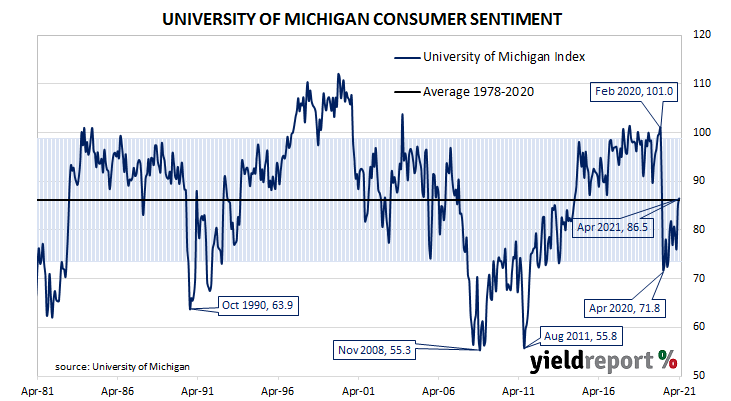Summary: US consumer confidence improves in April; University of Michigan index below consensus figure; view of present conditions improve, view of future conditions stable; stimulus spending, low interest rates, vaccinations main drivers; safety issues, inflation expectations hold back views of future.
US consumer confidence started 2020 at an elevated level. However, by March, surveys had begun to reflect a growing uneasiness with the global spread of COVID-19 and its reach into the US. After a plunge in April 2020, household confidence recovered in a haphazard fashion, holding at below-average levels. However, recent surveys suggest optimism may be likely to improve.
The latest survey conducted by the University of Michigan indicates the average confidence level of US households improved in April. The University’s preliminary reading from its Index of Consumer Sentiment registered 86.5, below the generally expected figure of 88.8 abut higher than March’s final figure of 84.9. Consumers’ views of current conditions improved while their expectations regarding future conditions remained stable in comparison to those held at the time of the March survey.
“Consumers in early April reported surging economic growth and strong job gains due to record stimulus spending, low interest rates, and the positive impact of vaccinations,” said the University’s Surveys of Consumers chief economist, Richard Curtin. He noted concerns regarding vaccine safety and “a surge in year-ahead inflation expectations” had held back households’ expectations of the future.

US Treasury bond yields hardly moved on the day. By the close of business, the 2-year yield remained unchanged at 0.15%, the 10-year yield had ticked up 1bp to 1.58% and the 30-year yield also remained unchanged at 2.27%.
More-confident households are generally inclined to spend more and save less; some increase in household spending could be expected to follow. As private consumption expenditures account for a majority of GDP in advanced economies, a higher rate of household spending growth would flow through to higher GDP growth if other GDP components did not compensate.

